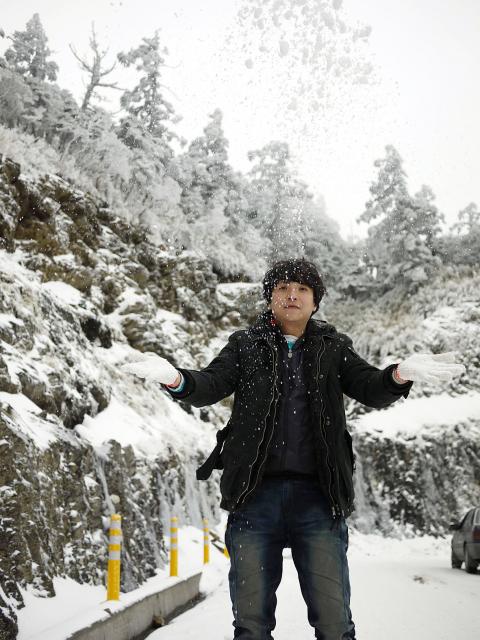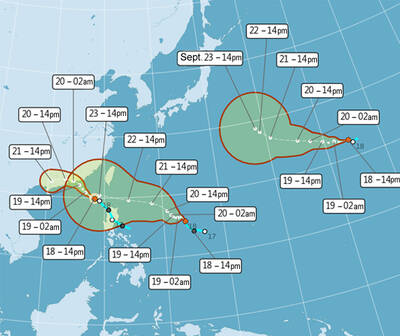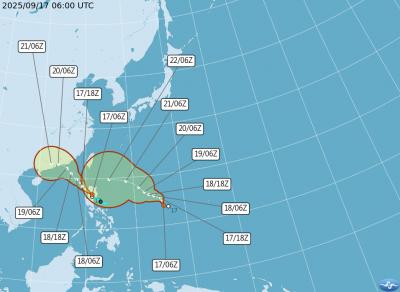There’s still about a month to go until winter officially ends, but the number of days on which weather stations in Taipei have shown temperatures falling below 10oC has already reached 13, with six days recorded last month and seven days in December.
According to the Central Weather Bureau (CWB), over the past 30 years Taipei had an average of 3.3 days of low temperatures in January — defined as less than 10oC.
The average temperature in Taipei last month was 13.8oC, 2.35oC lower than the 30-year temperature average of 16.15oC, marking the lowest average monthly temperature in 40 years and the ninth-lowest recorded in the past 100 years, it said.

Photo: Hua Meng-ching, TAIPEI TIMES
“It was not only in Taipei that was cold this winter, but nationwide,” said Chia Hsin-hsing (賈新興), chief of the bureau’s long range forecast section.
Chia said that among the 25 weather stations nationwide, 21 recorded low temperatures that were among the tenth-lowest since the stations were established — the four stations in Taichung, Yushan (玉山), Hualien County and Alishan (阿里山) were exceptions.
Bureau statistics reinforced the widely held perception that this winter has been colder than average, but scientists have not yet come to a conclusion as to the cause, analysts said.
Weather Forecast Center director Cheng Ming-dean (鄭明典) attributed the low temperatures to the impact of La Nina, an abnormal cooling of the equatorial Pacific Ocean, coupled with a negative phase of Arctic Oscillation (AO), which allows frigid polar air to slide south, displacing warmer air to the north.
The AO is a natural weather pattern of differences in air pressure between the Arctic and mid-latitudes. When the AO is in a negative mode, the pressure gradient weakens, with air pressure higher than average in the Arctic and lower than average in the mid-latitudes.
“Both events bring cold to certain areas. This year the temperatures of the affected areas got cooler as La Nina coincided with the negative Arctic Oscillation,” Cheng said.
Located in one of the three paths along which arctic air masses flow southward from Siberia toward Inner Mongolia into northeastern China, Japan and the Korean Peninsula, Taiwan also receives cold arctic air when it plunges into the region, Cheng said.
Countries lying along the route when cold air from the Arctic spreads out southward into Western European countries such as Norway, Germany and the UK, also saw damage caused by unusually extensive snow, while the weather pattern allowed arctic air from northwestern Canada to flow straight into the eastern portion of the US.
It may seem contradictory that the rise in world temperature leads to extra cold winters, but Cheng said that global warming is one the reasons behind the increase in frequency of cold arctic masses moving southward, despite the link being unattested.
It’s “theoretically possible” because increased ice melting, as a result of global warming, can heat up the upper layers of the atmosphere, which will then lead to changes in wind patterns over the Arctic, causing Arctic cold air masses to move outward, Cheng said.
Peng Chi-ming (彭啟明), chief executive of the Weather Risk Management Co, said scientists did not yet know how global warming affects AO because it was not until as recently as 10 to 20 years ago that scientists gained more knowledge about the weather pattern.
“Just because there has been an increase in frequency at which Arctic Oscillation is in a negative mode in recent years does not mean that it is a result of rising [global] temperatures, despite the fact that the scientific evidence for the existence of global warming continues to mount,” he said.
Liu Koung-ying (劉廣英), dean of the atmospheric sciences department at the Chinese Culture University, said “this winter has not been cold if the average temperature is put in the context of a long enough cycle, say 30 years,” instead of three years or 10 years.
According to the CWB, the average temperature in December and last month in Taipei was 15.6oC, slightly lower than an average of 16.85oC between 1981 and last year and an average of 15.9oC between 1951 and 1980.
Further cases of record--shattering winters include 1975 when it rained all February, 1983 when there was a consecutive 65 days of snow on Yushan and 1963 when the average daily temperature was below 10oC for 28 days in January, he said.
“I do not see this winter as unusually cold, compared with the winters I have been through in my life. I would say that this is a normal winter. Warmness in winter is abnormal,” Liu said.
In recent years the Earth has been rich with weather abnormalities caused partly by the east-to-west trade winds characteristic of La Nina, mostly likely linked to the continued increase in carbon dioxide and partly by a north-south seesaw weather pattern in the North Atlantic, known as North Atlantic Oscillation (NOA), which is closely related to AO, Liu said.
During negative phases of the NOA, big zones of high pressure spreading down from Greenland stick around for weeks, dragging bitterly cold winds out of the Arctic, said Liu, adding that it occurs periodically and naturally when Arctic air masses accumulate to a certain level over a period of time.

PEAK MONTHS: Data showed that on average 25 to 27 typhoons formed in the Pacific and South China seas annually, with about four forming per month in July and October One of three tropical depressions in the Pacific strengthened into a typhoon yesterday afternoon, while two others are expected to become typhoons by today, Central Weather Administration (CWA) forecaster Lee Ming-hsiang (李名翔) said yesterday. The outer circulation of Tropical Depression No. 20, now Typhoon Mitag, has brought light rain to Hualien, Taitung and areas in the south, Lee said, adding that as of 2pm yesterday, Mitag was moving west-northwest at 16kph, but is not expected to directly affect Taiwan. It was possible that Tropical Depression No. 21 would become a typhoon as soon as last night, he said. It was moving in a

A Taiwanese academic yesterday said that Chinese Ambassador to Denmark Wang Xuefeng (王雪峰) disrespected Denmark and Japan when he earlier this year allegedly asked Japan’s embassy to make Taiwan’s representatives leave an event in Copenhagen. The Danish-language Berlingske on Sunday reported the incident in an article with the headline “The emperor’s birthday ended in drama in Copenhagen: More conflict may be on the way between Denmark and China.” It said that on Feb. 26, the Japanese embassy in Denmark held an event for Japanese Emperor Naruhito’s birthday, with about 200 guests in attendance, including representatives from Taiwan. After addressing the Japanese hosts, Wang

One of two tropical depressions that formed offshore this morning could turn into a moderate typhoon by the weekend, the Central Weather Administration (CWA) said today. Tropical Depression No. 21 formed at 8am about 1,850km off the southeast coast, CWA forecaster Lee Meng-hsuan (李孟軒) said. It is expected to move in a northwesterly direction as it continues building momentum, possibly intensifying into Typhoon Mitag this weekend, she added. The radius of the storm is expected to reach almost 200km, she said. It is expected to approach southeast of Taiwan on Monday and pass through the Bashi Channel between Tuesday and Wednesday,

About nine Taiwanese are “disappeared,” detained, or otherwise deprived of freedom of movement in China each month, the Mainland Affairs Council (MAC) said yesterday. Between Jan. 1 last year and Aug. 31 this year, 188 Taiwanese travelers went missing, were detained and interrogated, or had their personal freedom restricted, with some questioned in airports or hotel lobbies, the council said. In a statement ahead of the Mid-Autumn Festival, the council urged people visiting China for any reason to be highly vigilant and aware of the risks. Of the reported cases, 50 people were “disappeared” after entering China, 19 were detained and 119 had